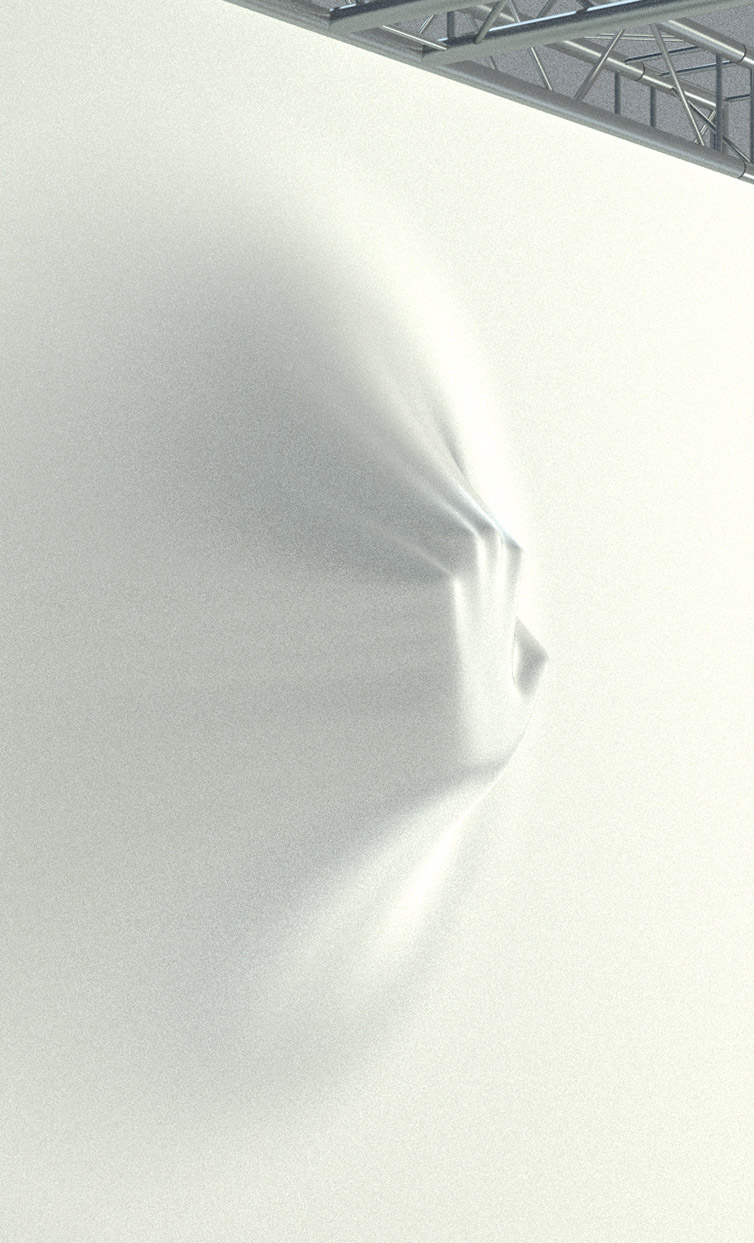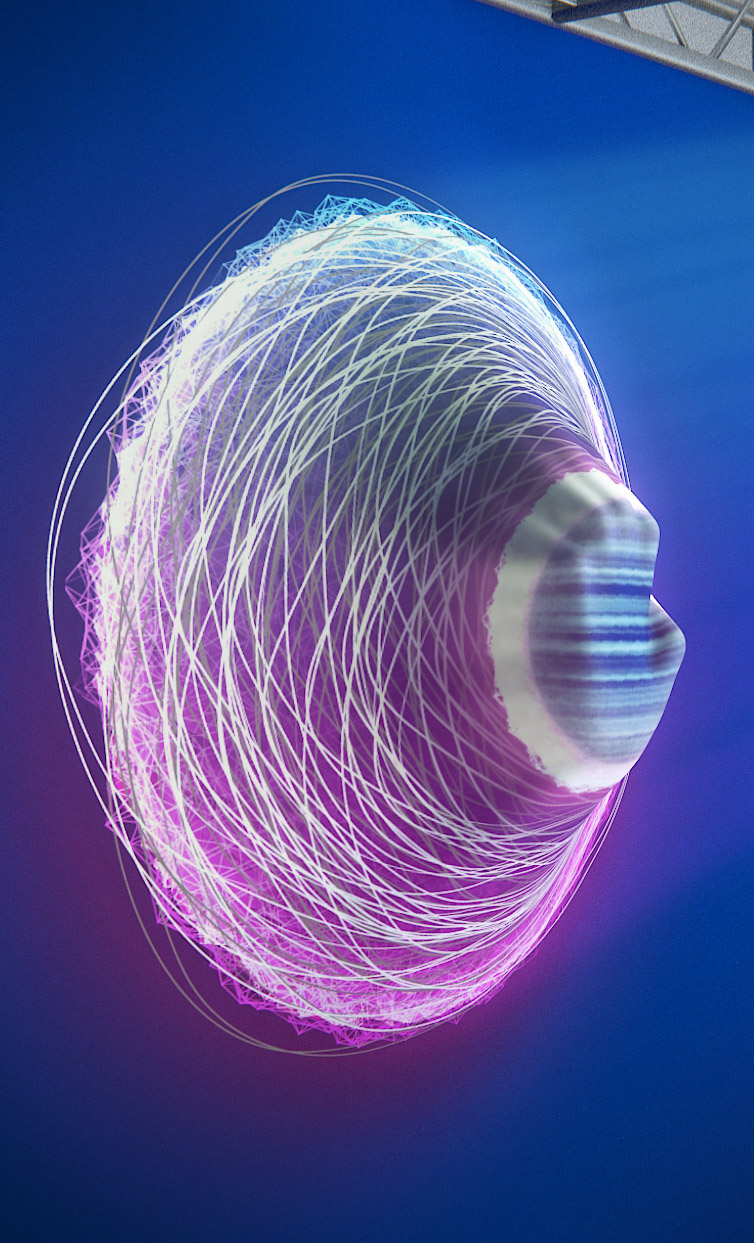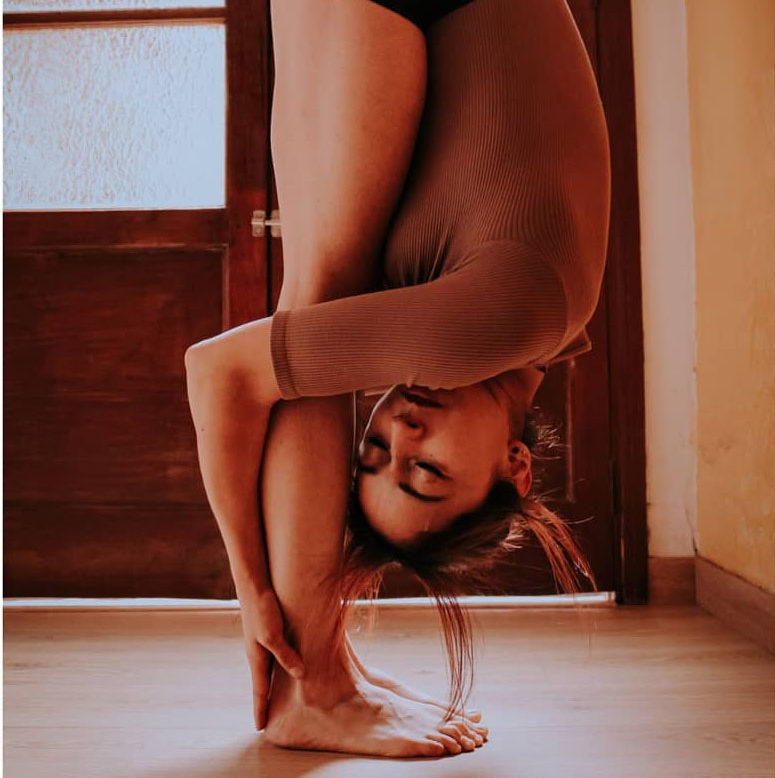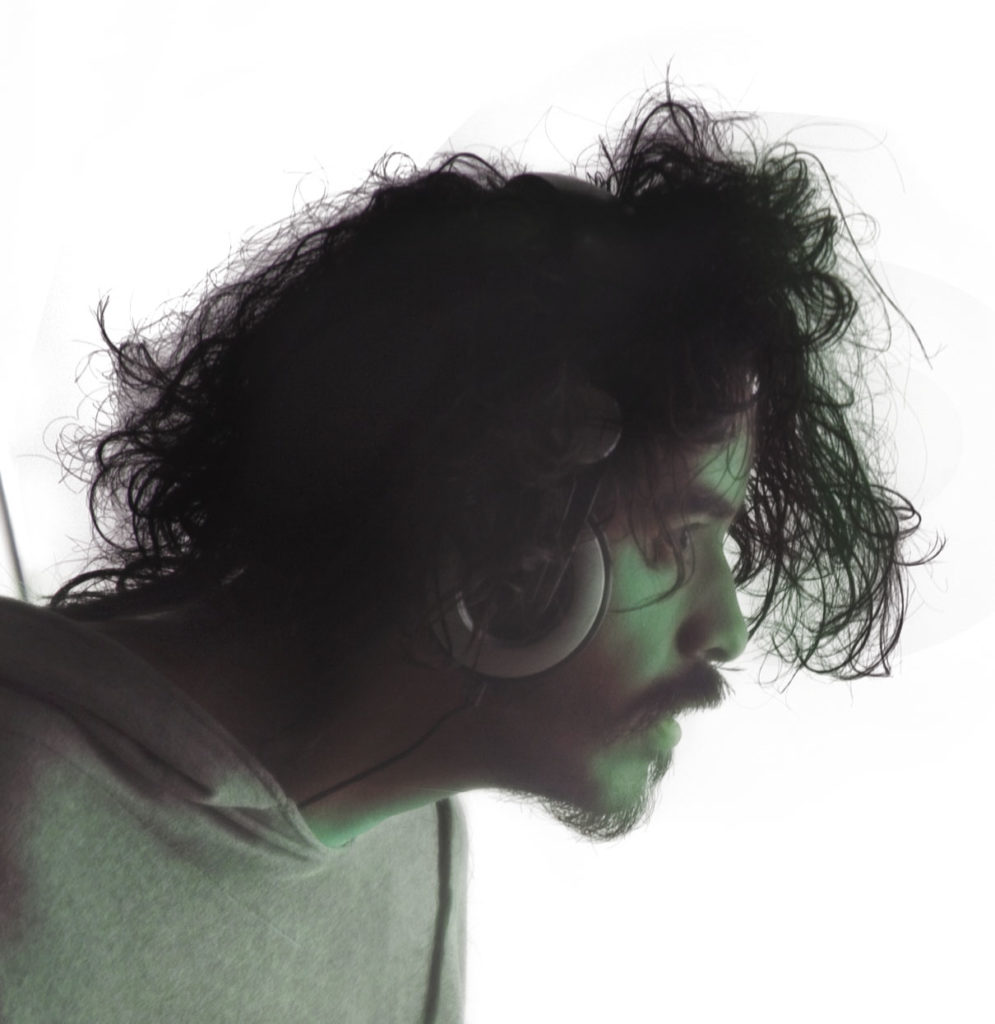enthalpy
Enthalpy Analysis, (research work).
Specialization in Combined Artistic Languages.
The work is called Enthalpy, and part of this concept of physics, which is understood as the energy necessary to make a change of state, in this case the work uses movement as a catalyst for the transformations of color and sound. Created by Margareth Arias and Carlos Adrián Serna, it is an installation-performance designed as an instrument, as a support for user-machine interaction. It is made up of a flexible fabric of 2 x 2 meters, in a relatively dark and silent space, mapped through a 3d camera, which scans the surface of the fabric. The installation is initially activated by Arias who, in the course of her movement, deforms it, while a group of specialized programs interpret the information identifying the points of contact, highlighting them through color and generating musical notes, to which the artist responds through of movement, building the sound piece while interpreting it; after a while, Arias leaves the installation for the public to interact.
We are first interested in dealing with the contributions of technology to the work, through the concept of interface, which Giannetti (2004) has reviewed, where it is granted the status of mediator in the two-way communication that occurs between the user and the machine. In the case of Enthalpy, the artists have developed a program that interprets the information that the user provides to the interface, through the camera and the canvas where the input information is generated. This program orders two other specialized programs to generate a sound response and a light response, thus creating a composition through body movements on the canvas. Thus, the open structure described by Giannetti (2004) is discovered, which allows a break with sequentiality, where a script established by the authors is no longer obeyed, but rather the creation of the work in the process of user interaction. This open structure is possible through the work carried out by the interface, which takes information from what is happening on the canvas and allows the temporary construction of the work, through sound and colored light.
In the acknowledgment made by Berenguer (1999), he points out the program as one of the most important components of computer science. The program contains the compendium of instructions that enables the artists to make this work, assisting both in the elaboration of the musical and visual composition as well as in the interactive stage with the user. Enthalpy depends on a program created by Serna, with the C++ programming language, which is the
responsible for mapping the fabric giving it a grayscale image, where the dark is interpreted as the initial position of the fabric and the lightest as the closest. Thus, depth is detected when any forward movement is made, to project the colors through videomapping software, while simultaneously the audio software is based on a matrix that divides the surface of the canvas (2×2 mt) , producing different musical notes depending on where on the fabric it is deformed and the speed with which the user's body does so. The artist uses these programs in the composition stage, which allow him to simulate the experience and refine the details of the final composition, this is called the assistance work. Next, the intermediary work that the program performs to carry out the exchange of information can be identified, interpreting the information that is generated from the user's body in contact with the fabric, speed and number of touches, and translate it into colored light and sound. Finally, the work of the program as an automatic content generator is noted, being able to make compositions that have not been previously established, due to the interactive characteristic that responds to the varied stimulus of the bodies on the canvas. Thus, depending on the number of people who manipulate the surface, several notes may be sounding that create instantaneous compositions, and in the same way random places where the color appears and becomes more or less intense, causing the sound and visual configuration to be continuously modified. , instantaneously and without having anticipated beforehand.
Secondly, we will deal with the bodily relationship with the work, which allows us to locate the changes that Jones (2011) warns of from the 1960s, when artists turn their gaze towards the body, repressed by modern ideals and the war, seeking its liberation through performance, the artist's body is introduced using everyday actions and involving the viewer in a participatory way. The work uses these premises, which can be identified more precisely in the contact improvisation encounters in the 1960s, when Arias's body (trained in dance) inaugurates the installation through its improvisation, and then gives room for the daily movement of untrained bodies that have a creative potential just like the body of the artist, giving rise to a democratization of art. Thus, the work is not reduced to the body of Arias that produces sounds and color on the canvas through its movement, but to the possibility that any body is the creator of these sound and light compositions.
Groys (2015) takes up this democratization to refer to the installations, where the artist
authorizes viewers to interact in the space of the work, although they must submit to
the rules of the game signed by him. For this author, the artist establishes a democratic regime
without belonging to it, in Enthalpy you can see how Arias introduces the rules in a
example but does not share the same space with subsequent users, repeating
this process every half hour. Without ignoring the transformation of the transit space that
1 will conform the installation through the symbolic privatization of public space, without
this is contrary to democratization, which, as Groys (2015) points out, never emerges democratically; For the case of Entalpía presented at V2B – visual visual Bogotá – a meeting of art and digital technology in Colombia, the artists Arias and Serna configured a space with no light and no stage, to allow free movement and openness towards interaction with the viewer. This symbolic privatization is conceived from the manipulation of space that artists make in the exhibition of their work and how they present it to the viewer.
On the other side we have the experience of the viewer who intervenes as an interactor in a constant dialogue with the installation, cataloged by Gianneti (2004) in four steps: through the structure that develops bidirectional communication through the use of a mediator, in this case the information translator program that allows access to this open structure through the continuous generation of new information, understood as visual and sound compositions through body movements generated by the public on the canvas; in this way, a human-machine communication is generated: approached on the one hand according to Giannetti (2004) who affirms that the spectator, being an external element to the work, controls its processes, generating an input or message sent to the program, which at the same time it propitiates an output or output of information. On the other hand, Aguilar (2008) reinforces the position by referring to a body that uses technology, to join it and in this case generate an artistic link, a symbiosis between man - machine, where neither of them separately builds the work, since it is in this physical contact where the means to feed back and generate new information is found. It is also relevant to think of perception in Enthalpy, for this purpose the artists adapt the user-interface communicative process to the experience based on human behavior. In
1
Groys, B.; Go public. The transformations of art in the contemporary agora. (2015) Buenos Aires. P.54
this process of trial and error, Arias and Serna carry out an ergonomic study of the surface of the fabric through movement, to identify the sound and light possibilities with the intervention of the body in a vertical position in front of the fabric, contemplating variables such as the impossibility of the use of both feet at the same time and the ease of use of both hands, face, arms and trunk on the surface; As a result of this, they propose the distribution of the sound and visual elements according to the dialogue that the viewer may have with the work, allowing more visible projections to be generated through the depth that the body exerts against the canvas and the distribution, height and intensity of the sound. translated into dynamics by the speed and depth with which the surface is touched. Finally, for the possibilities of this constant dialogue, the translation of information becomes important, which in Enthalpy goes hand in hand with the C++ programming language, which translates the stimulus generated by the body and sends them to two specialized programs facilitating interaction among them: mapping software, the audio and midi sequencer, with which the artists have created five (5) color and three (3) sound compositions, which alternate to be manipulated.
In this production the purpose of the singular work can be made evident, Enthalpy does not exist if there are no bodies in space that create it, thus each body that comes into contact with the large canvas creates a new work, realizing through the movement of his body a sound and light composition that will be different in each case. In this way, the work ceases to be singular, both the viewer and the artist, so Brea (2003) decrees the end of singularities. The viewer is now a multitude of viewers who can have simultaneous contact with the work, thus both the work and the experience are built collectively, displacing the artist from his role as singular and privileged creator, causing both the artist and the viewer to be creators. , albeit at different times. Likewise, the singular temporality of the appreciation is altered, which is no longer determined by the moment of confrontation as with the work, but is modified at the same time as it is. Following Cuadra (2009), Brea's thesis can be related to Benjamin's concern, with regard to authenticity or aura, both state that the work does not have this authentic characteristic as it is easily reproducible, an original work will no longer exist. and unique. With the arrival of hyperreproducibility, this new condition of art becomes emphatic, Enthalpy does not have an original form from which they later emerge.
copies, the work is always original to the extent that it is created through the interaction of the bodies and the interface. In addition, Groys (2015) states that the installation is on the other side of reproduction, offering an aura of here and now, this re-auratization is possible because in this digital age a copy is no longer a copy, but a new original in new context.
Finally, the artists propose the work as an instrument to be activated by those attending the installation, a complex dynamic system, as stated by Sardón (2006). Enthalpy is a set of rules that allow communication, using the installation as a means to establish the changing contact, therefore dynamic, of the users and the machine. The result of this interaction depends on two transformations: the first is the programming established by the artists according to the variables that the system will consider, Arias and Serna have modeled the rules under which the machine is related to the user, establishing notes along the surface and colors that depend on depth, and excluding some such as the system's reaction to the gesture of pulling the fabric; the second is the input information that depends on the interactor; Being a system of a dynamic nature, the input provided by the users cannot be anticipated, due to variables such as the number of subjects in the space and their indeterminate behavior in front of the canvas, nor can the final form of the work be anticipated, but the medium that can create it.
Enthalpy is then a composition intervened by the viewer who acts as a performer, catalyst of the work, which according to their sensitivity and understanding of the installation – through the actions they perform on the canvas – in an act of improvisation generates an open work. We speak of improvisation since the interaction of the viewer against the canvas generates a feedback, where the movement is the generator of music and light, but at the same time these materials are what stimulate the movement of the body, thus this improvisation obeys the autonomy of the interactor who decides with what intensity and speed to transform the surface of the canvas, generating changes in the visual and sound possibilities of the work. In this way one can speak of an unfinished work, while the interactors constantly intervene generating a work together with Serna and Arias, with the particularity that it will never be repeated and always original, thus changing the relationship between artist and public. .
Martinez, A, & Rodriguez, A. (2018)
Enthalpy Analysis, (research work).
Specialization in Combined Artistic Languages,
National University of the Arts, Buenos Aires, Argentina.



